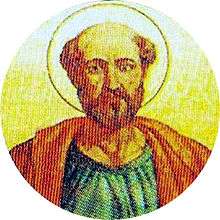Pope Telesphorus
| Pope Saint Telesphorus | |
|---|---|
 | |
| Papacy began | c. 126 |
| Papacy ended | c. 137 |
| Predecessor | Sixtus I |
| Successor | Hyginus |
| Personal details | |
| Birth name | Telesphorus |
| Born | Terranova da Sibari, Calabria, Italy |
| Died |
c. 137 Rome, Italy, Roman Empire |
| Sainthood | |
| Feast day |
|
| Venerated in | |
| Attributes | Papal vestments |
| Patronage | Carmelites |
Pope Saint Telesphorus (died c. 137) was the Bishop of Rome from c. 126 to his death c. 137, during the reigns of Roman Emperors Hadrian and Antoninus Pius. He was of Greek ancestry and born in Terranova da Sibari,[1][2][3] Calabria, Italy.
Biography
Telesphorus is traditionally considered as being the seventh Roman bishop in succession after Saint Peter. The Liber Pontificalis mentions that he had been an anchorite (or hermit) monk prior to assuming office. According to the testimony of Irenæus (Against Heresies III.3.3), he suffered a "glorious" martyrdom. Although most early popes are called martyrs by sources such as the Liber Pontificalis, Telesphorus is the first to whom Irenaeus, writing considerably earlier, gives this title.
Eusebius (Church History iv.7; iv.14) places the beginning of his pontificate in the twelfth year of the reign of Emperor Hadrian (128–129) and gives the date of his death as being in the first year of the reign of Antoninus Pius (138–139).
In Roman Martyrology, his feast is celebrated on 5 January;[4] the Greek Church celebrates it on 22 February.
The tradition of Christmas Midnight Masses, the celebration of Easter on Sundays, the keeping of a seven-week Lent before Easter and the singing of the Gloria are usually attributed to his pontificate, but some historians doubt that such attributions are accurate.
A fragment of a letter from Irenæus to Pope Victor I during the Easter controversy in the late 2nd century, also preserved by Eusebius, testifies that Telesphorus was one of the Roman bishops who always celebrated Easter on Sunday, rather than on other days of the week according to the calculation of the Jewish Passover. Unlike Victor, however, Telesphorus remained in communion with those communities that did not follow this custom.
The Carmelites venerate Telesphorus as a patron saint of the order since some sources depict him as a hermit living on Mount Carmel.
The town of Saint-Télesphore, in the southwestern part of Canada's Quebec province, is named after him.
See also
References
- ↑ SAINT TELESPHORUS (119-127). SAINT HYGINUS (127-139). SAINT PIUS I (139-142)
- ↑ The Pope Podcast: Pope Telesphorus
- ↑ it:Papa Telesforo
- ↑ The Telesphorus commemorated on 5 January in the General Roman Calendar as in 1954 was in fact not the Pope but an otherwise unknown African martyr – Calendarium Romanum (Libreria Editrice Vaticana, 1969), p. 112).
Further reading
- Attwater, Donald and Catherine Rachel John. The Penguin Dictionary of Saints. 3rd edition. New York: Penguin Books, 1993. ISBN 0-14-051312-4.
- Kelly, J.N.D. Oxford Dictionary of Popes. (1986). Oxford, England: Oxford University Press.
- Benedict XVI. The Roman Martyrology. Gardners Books, 2007. ISBN 978-0-548-13374-3.
- Chapman, John. Studies on the Early Papacy. Port Washington, NY: Kennikat Press, 1971. ISBN 978-0-8046-1139-8.
- Fortescue, Adrian, and Scott M. P. Reid. The Early Papacy: To the Synod of Chalcedon in 451. Southampton: Saint Austin Press, 1997. ISBN 978-1-901157-60-4.
- Loomis, Louise Ropes. The Book of Popes (Liber Pontificalis). Merchantville, NJ: Evolution Publishing. ISBN 1-889758-86-8
External links
| Wikimedia Commons has media related to Telesphorus. |
- (Latin) The Works of Pope Telesphorus (from Documenta Catholica Omnia)
- "Pope St. Telesphorus" Catholic Encyclopedia
 Chisholm, Hugh, ed. (1911). "Telesphorus". Encyclopædia Britannica (11th ed.). Cambridge University Press.
Chisholm, Hugh, ed. (1911). "Telesphorus". Encyclopædia Britannica (11th ed.). Cambridge University Press.
| Titles of the Great Christian Church | ||
|---|---|---|
| Preceded by Sixtus I |
Bishop of Rome Pope 125–136 |
Succeeded by Hyginus |

